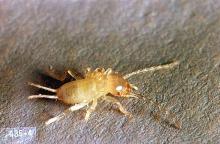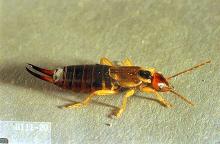Primarily European earwig (Forficula dentata)
Pest description and crop damage Adult earwigs are elongate, flattened, reddish-brown insects about 0.60 inch in length with forceps-like pincers on the end of their abdomens. They have chewing mouthparts and are fully winged. Young earwigs (nymphs) are similar in appearance but are white to olive green and lack wings. Earwigs are harmless to humans or animals, though they may give a slight pinch with their pincers. They can emit a foul-smelling liquid if alarmed. Earwigs feed primarily on decaying organic matter and are quite beneficial in that they consume smaller insects. However, they also may chew small holes in the tree leaves and in overripe fruit on stone fruit trees.
Biology and life history Earwigs overwinter just below the soil surface as both eggs and adults. In spring, females lay 20 to 50 smooth white to cream-colored eggs in the soil then nurture the immature nymphs. The young grow through four to five instars until they reach adults by late summer. In fall, females may lay more eggs. Earwigs are active at night. During the day, they hide in moist, shady places such as compost piles and beneath stones, boards, or debris. They rarely fly, but are carried, inadvertently, with lumber, cars, luggage, or other materials. At night, earwigs are attracted to lights.
Pest monitoring If you see damage to young leaves, you can confirm the presence of earwigs by placing a sheet of corrugated cardboard, hollow bamboo canes, sections of old garden hose, or similar material on the ground that provide shelter for earwigs. Check the materials each morning for the presence of earwigs. To dispose of the trapped insects, empty shelter traps each morning into a pail of water topped with detergent. Infestations spread slowly, as earwigs rarely fly.
Management-cultural control
Home Orchardists: Cultivation of the soil in early spring in areas where earwigs are present will disturb nests, physically damage earwigs, and expose eggs to predators. Do not allow debris and decaying organic matter to accumulate in the garden. Before the spring emergence of nymphs, wrap the trunk tightly with plastic wrap to ensure that earwigs do not crawl beneath the wrap. Earwigs are trapped with a sticky adhesive, or a similar material applied at the trunk of the tree to prevent their crawling up into the canopy of the tree. Apply the sticky adhesive to the plastic wrap, not the tree as that can soften bark. Remove these bands before winter. Earwigs may be trapped following the monitoring techniques described above. Earwigs are attracted strongly to fish oil and to some extent vegetable oil. Trap earwigs by filling a shallow container with the fish oil and burying it in soil up to its rim.
Management-biological control
Tachinid fly larvae are parasites of earwigs.
Management-chemical control: HOME USE
- azadirachtin (neem oil)-Some formulations are OMRI-listed for organic use.
- carbaryl-Apply around trunk at ground level only.
- gamma-cyhalothrin
- insecticidal soap-Some formulations are OMRI-listed for organic use.
- kaolin-Applied as a spray to leaves, stems, and fruit, it acts as a repellant to some insect pests. Some formulations are OMRI-listed for organic use.
- plant-derived essential oils-Some formulations are OMRI-listed for organic use.
- pyrethrins (often as a mix with other ingredients)-Some formulations are OMRI-listed for organic use.
- spinosad-Some formulations are OMRI-listed for organic use.
- zeta-cypermethrin
Management-chemical control: COMMERCIAL USE
Dormant and delayed-dormant spray
- carbaryl (Carbaryl 4L) at 2 to 3 quarts/A product. REI 12 hr. Spray around bases of trees and trunk. Extremely toxic to aquatic invertebrates; avoid spray drift and runoff to surface waters.




